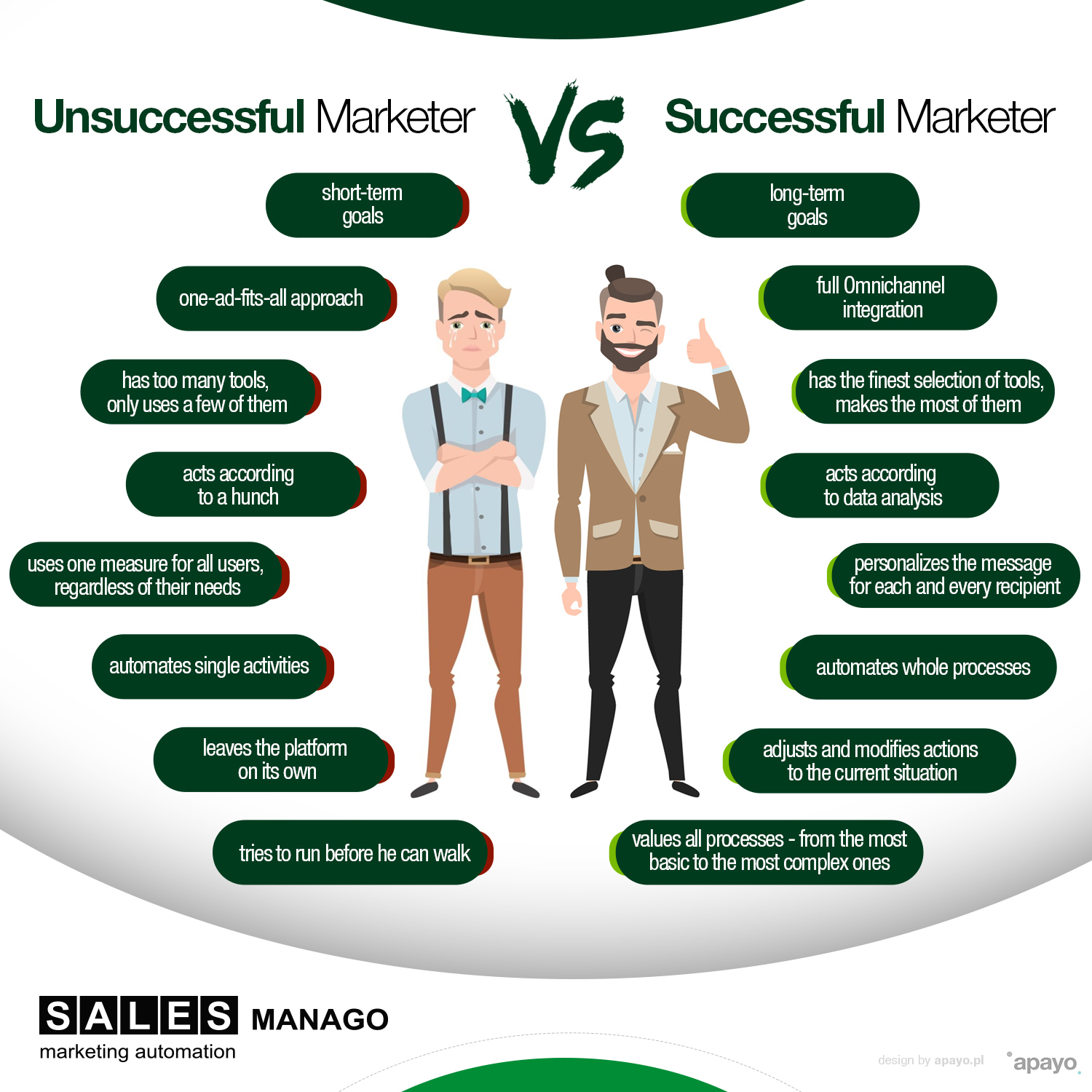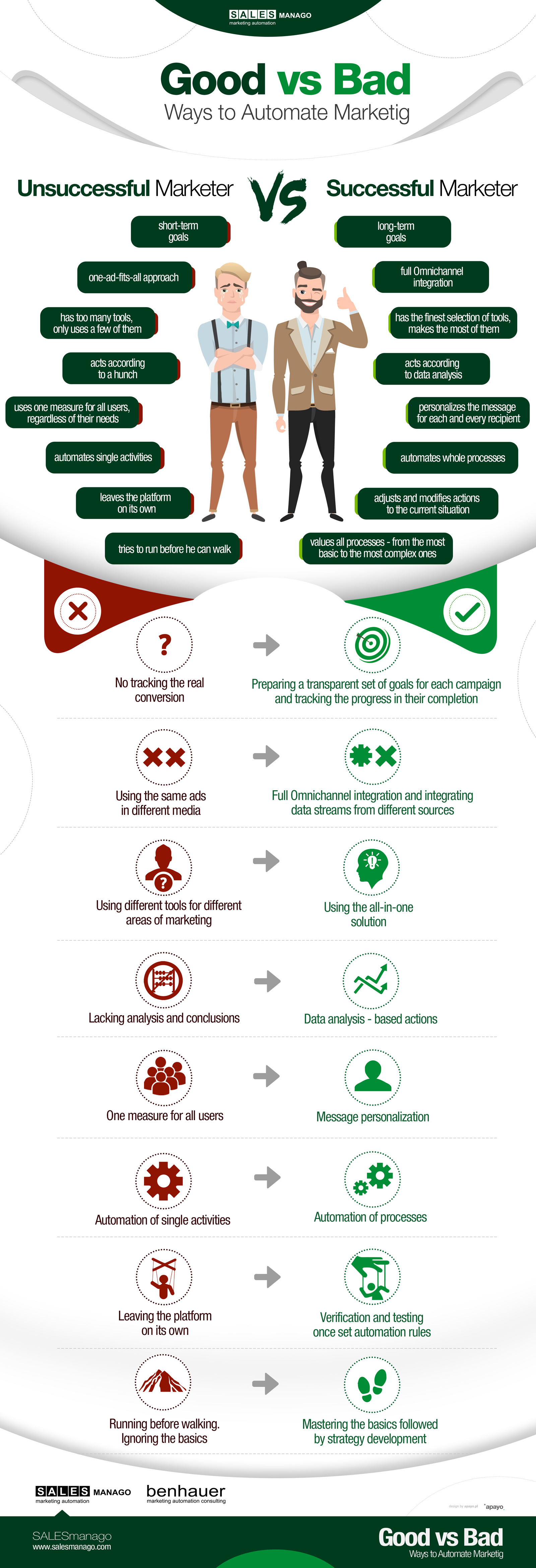 So you think you can automate, right? You bought a marketing automation platform license, made a database import, and even implemented the tracking code on your website. Is there anything that could stop you from becoming the new Jeff Bezos?
So you think you can automate, right? You bought a marketing automation platform license, made a database import, and even implemented the tracking code on your website. Is there anything that could stop you from becoming the new Jeff Bezos?
Unfortunately, there are some common yet severe mistakes you can unwillingly make while implementing your strategy. Let’s name eight most popular errors and consider how to avoid them.
If you don’t remember what CRM, ERP, Omnichannel & Agile mean download Digital Marketer’s Pocket Dictionary at once and check those terms right away.
At first, let’s consider what makes a marketer god or bad at what he does. The simplest way is to evaluate their results, not the actions themselves. As they say: Finis coronat opus. And so it does in marketing. We already said that:
Following that logic, one can assume that a good marketer is a person who will generate (directly or indirectly) the highest income while keeping the costs at the lowest level possible. Given that the majority of the companies earn by offering their products or services to the customers, quality of a marketer can be measured through a quantity and quality of the leads he will generate. Other important variables are increasing the retention rate, increasing the average order value and lowering the advertising cost. These tasks require both long-term planning and data analysis as well as skillful message juggling through the various channels.
Let’s consider both cases, point by point, and figure out how to prevent those counter-effective habits in digital marketing.
-
- Short-Term Goal, or No Goal at All
Many marketers’ problem is that they don’t mark their goals on the wider scale. And it also applies to the way they automate processes. How come? – You may ask. It’s easy – they aren’t used to setting goals at all. They don’t have transparent KPI system, they work mostly with the vanity measurements such as Facebook likes, and they don’t track the real conversion. No wonder they aren’t sure what to do with such complex a tool. They automate ‘this and that’ without a wider perspective and leave analytics to those squares in the analytics factory.
How to avoid it: Learn your marketing department how to… count. Prepare a transparent set of goals for each campaign. Divide them into smaller, easily achievable goals and teach people how to track the progress in their completion. Once they know what they have to achieve, they will automate logical workflows instead of single actions which, if uncoordinated and unorganized can cause logical loops and thus paralyze the bigger processes.
- One-Ad-Fits-All Approach
Some of us remember the world from before the Internet boom in the ‘90s. It was normal then to advertise properly in multiple channels (yes, we had many communication channels despite the lack of the World Wide Web!) – video ad or product placement in TV, a short jingle in radio, printed story, or large picture in the newspaper, etc. It lacked only a deep integration of data from different channels that is possible today. Today, however, some marketers seem to forget about the ginormous possibilities offered by digital marketing tools. That’s why it’s even harder to understand why they use the same ads and same automation settings in different media, e.g. mobile app, video sharing service, website, blog, social network, etc. Each and every one of them has its own characteristics and reacts differently to various content. The automation should be fitted to the channel as well. Example? While website visitors present rather static behavioral patterns (afternoon press review, weekend shopping spree, holiday purchase rampage), mobile users require a little bit more dynamic approach. They can spend hours playing a game during one week, and the next on they will abandon it because of the incoming deadline. And after that, they’ll start playing only on weekends.
How to avoid it: The crucial part is to recognize particular channel’s characteristics. There are numerous online podcasts and how to’s that can help you in building a reasonable automation strategy across the multichannel. If you want your automation structure to be dynamic and complimentary use graphic workflow creators and analyze results. Use agile approach so you can react to dynamically changing conditions.

- Too Many Tools
Have you ever seen a newbie who bought all recommended items in a professional store and now has no clue how to use them efficiently? And now think of a pro who can do almost anything with one swiss-army knife. That’s the difference – the well-known saying puts quality over quantity, and you should bear it in your mind while choosing the toolset. The email marketing tool, the Social media tool, the Mobile app tool, analytics tool, CRM tool… if they are separated, the chances of high efficiency lower severely – the data won’t be integrated, you’ll waste your time setting and optimizing them all, and you’ll get frustrated by the unpredictable outcome.
How to avoid it: Choose your tools with caution. Do your research, attend some webinars (check out our webinar schedule and pick the one you like the most!), ask experts, user recommendation services such as G2Crowd (click to find our account and share your opinion about the system) or GetApp (SALESmanago profile – feel free to share your thoughts!), talk to your friends. Make a checklist of all features you need, define budget and pro/con all fitting tools. Look for the all-in-one solution – it’ll integrate the data from different sources and processes. Remember: it’s always better to automate multiple processes from one panel – it minimizes the risk of making logical errors and eases verification of processes.

- Lack of Analysis and Conclusions
Not all of them, but many marketers can’t count or lack a decent tool for this purpose. Seriously – their awareness of which metrics are important is not sufficient. What’s more important, even if served the set of statistics they tend to have a problem with drawing reasonable and useful conclusions. So how the heck could they work normally and make something more than burning company’s money? If the automation is done without a deep insight, it might work, but more often it will just destroy company’s image.
How to avoid it: Provide your team with the best tools possible and teach them how to use such tools. Each developer offers multiple opportunities to learn their tool to make user experience unforgettable (in the most positive way possible). SALESmanago, for example, offers you series of webinars, where you can learn our tool from a to izzard, the support section on the website, e-learning platform, live support, ebooks and case studies so you can see real-life examples of platform usage.

- One-Size-Fits-All Approach
People like to be treated individually. Of course, there are some repeatable patterns. However, not everyone will respond positively to another mass mailing. We drown in the flood of information; we choke with spam. Automation rules use really detailed information about users behavior so it would be a shame not to use it. You have dozens of triggers and conditions that can be used to truly personalize your message.
How to avoid it: First of all – segment your database! Use tags added according to website behavior, scoring, purchase activities, reaction to sent messages or information from external systems (CRM, ERP, loyalty systems), etc. Secondly, build buyer personas (we have a whole ebook on how to build Buyer personas in ecommerce) and use them to address different campaigns and rules. And last but not least analyze your clients’ buyers journey to find proper triggers for different personas on the various stages of purchase processes.

- Automation of a Single Area
It’s great that people automate marketing activities. And yes, for some companies automation of a single area will be a life-changing action. Nonetheless, bear in your mind that marketing and sales are dynamic processes that cannot exist without each other, and you can find a reflection of this fact while planning and running the campaign and preparing automation workflow. So if you already automated email marketing but didn’t automate tagging nor sales alerts rethink changing your approach to a more holistic one.
How to avoid it: Stop seeing marketing and sales as sequences of small separate action. The best results are generated by the synergy effect occurring after you combine them into the consistent process. The separate automation has no chance to become as powerful as the whole process. Believe me, we know something about it – we even partially based our Customer Value Marketing on this assumption. Read our CEO’s manifesto!

- Leaving the Platform on Its Own
Do you know the legend about Golem (not to be mistaken with J. R. R. Tolkien’s Gollum)? There are many of them: The Golem of Prague, The Golem of Chełm, etc. More or less it’s a story of a clay human-shaped creature revived with a magic word by a powerful man. No matter how they end, all of those stories mention about one of the Golems’ flaws – they don’t think, they just follow the orders. At first glance it is tempting, but imagine unsupervised Golem, that was told to dig a wheel. That’s right! He will never stop until destroyed by natural forces like heat from the center of our planet, or enormous pressure… And now back to automation. No matter how intelligent your platform is, it still needs supervision, unless you want to watch your customer’s inboxes burn (with tons of spam), or even worse – seeing your potential customers being unaware of the possibilities offered by your company because of poor recognition of their needs.
How to avoid it: Remember, that even the most complex platform won’t replace the human that operates it. Always check and test your rules and review them once in a while.

- Running before walking
Today’s Marketing Automation platforms offer various possibilities and tools. Some of them are simple and some resemble magic to those not-so-familiar with the modern technology. It’s perfectly understandable that people want to use the best of them. But a beginning is a very delicate time, to quote F. Herbert’s Dune. It’s important to understand how the platform works and what it can do for you. If you start with setting the whole workflow with generated coupons, URL adjusted popups, and God knows what else you’ll be sorry faster than you think. It’s okay to use all tools you have paid for, but if you won’t learn basics, it will rather lead to frustration instead of spectacular effects.
How to avoid it: Start small. Set a Welcome message to all those, who registered on your website. Prepare a Lead Nurturing. Learn how to segment your base. Again – contact experts and attend webinars. Ask your Project Manager for help. Think of all useful, yet simple things you can and should automate in a first place, and automate them!

- Short-Term Goal, or No Goal at All
And these are, my dearest reader, the top 8 dumb ways to automate. Of course, this text wasn’t written to offend anyone. It was created to remind all of us, that sometimes we make mistakes, and to help identify and avoid some practices before they sabotage our success. We are eager to know your beginnings, tips and tricks for the perfect automation. Share your experience in the comments!
PS. You can download all pictures combined in a one beautiful infographic 🙂



 Follow
Follow
















